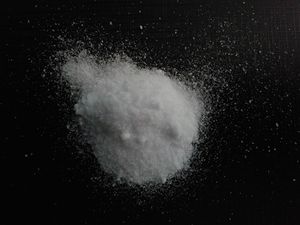Ammonium bicarbonate
 Food grade NH4HCO3
| |
| Names | |
|---|---|
| IUPAC name
Ammonium hydrogen carbonate
| |
| Other names
AmBic
Ammonium hydrogen carbonate Azanium bicarbonate Azanium hydrogen carbonate Bicarbonate of ammonia Baking soda Hartshorn Powdered baking ammonia | |
| Properties | |
| CH5O3N NH4HCO3 | |
| Molar mass | 79.056 g/mol |
| Appearance | White crystalline solid |
| Odor | Ammonia |
| Density | 1.586 g/cm3 |
| Melting point | 41.9 °C (107.4 °F; 315.0 K) (with decomposition) |
| Boiling point | 107 °C (225 °F; 380 K) (complete decomposition) |
| 11.9 g/100 ml (0 °C) 21.6 g/100 ml (20 °C) 36.6 g/100 ml (40 °C) | |
| Solubility | Insoluble in acetone, benzene, ethanol, ethers, methanol |
| Solubility in glycerol | 10 g/100 ml |
| Vapor pressure | 58.9 mm Hg (25.4 °C) |
| Hazards | |
| Safety data sheet | Sigma-Aldrich |
| Flash point | Non-flammable |
| Related compounds | |
| Related compounds
|
Ammonium carbonate |
| Except where otherwise noted, data are given for materials in their standard state (at 25 °C [77 °F], 100 kPa). | |
| Infobox references | |
Ammonium bicarbonate or ammonium hydrogen carbonate is an inorganic compound with the chemical formula NH4HCO3. In older literature it may be referred to as hartshorn, as is ammonium carbonate.
Contents
Properties
Chemical
Ammonium carbonate will slowly decompose to give off ammonia, carbon dioxide and water vapors. The reaction occurs faster at higher temperatures:
- NH4HCO3 → NH3 + H2O + CO2
Ammonium carbamate is another potential by-product of decomposition.
When treated with acids, it releases carbon dioxide:
- NH4HCO3 + HCl → NH4Cl + H2O + CO2
It also reacts with alkali metal halides, giving ammonium halide and alkali metal bicarbonate:
- NH4HCO3 + LiCl → NH4Cl + LiHCO3
- NH4HCO3 + NaBr → NH4Br + NaHCO3
- NH4HCO3 + KI → NH4I + KHCO3
Physical
Ammonium bicarbonate is a white salt, soluble in water, but insoluble in organic solvents like methanol, diethyl ether, hydrocarbons. It will slowly decompose over time, even at low temperatures, releasing ammonia gas, which gives the salt a strong smell. The decomposition occurs faster at high temperatures.
Availability
Ammonium bicarbonate can be bought from food stores as "smelly" baking powder, either very pure or mixed with other carbonates, such as sodium bicarbonate or magnesium carbonate. To determine if it's pure ammonium bicarbonate, take a small amount of the smelly baking powder and heat it until it decomposes. If no residue remains, then it's very pure. Sometimes this type of baking powder is referred to as simply "ammonium", usually the label name.
Preparation
Ammonium bicarbonate can be made by bubbling an excess of carbon dioxide gas through a cold solution of ammonia.
- CO2 + NH3 + H2O → NH4HCO3
Alternatively, it can be made by heating a mixture of ammonium nitrate, sodium bicarbonate or carbonate, and water in one container, and channeling the generated gases into a chilled empty container, where it will crystallize on the walls.
Projects
- Ammonium carbonate synthesis
- Generate ammonia gas
- Synthesize any other ammonium salt. Both forms of Hartshorn are very convenient precursors to all salts of ammonium.
Handling
Safety
Ammonium bicarbonate gives off ammonia fumes, which are irritating and toxic if they build up in a closed environment.
Storage
Ammonium bicarbonate is best stored in closed containers and kept in cold places. To limit the ammonia gas released, you can store the ammonium bicarbonate in a resealable bag, which in turn can be placed in a container. Avoid storing this compound near anything with copper or copper alloys, as well as the acid cabinet.
Disposal
Ammonium bicarbonate can be neutralized with any acid and safely dumped in both soil and down the drain, as it poses no danger to the environment.